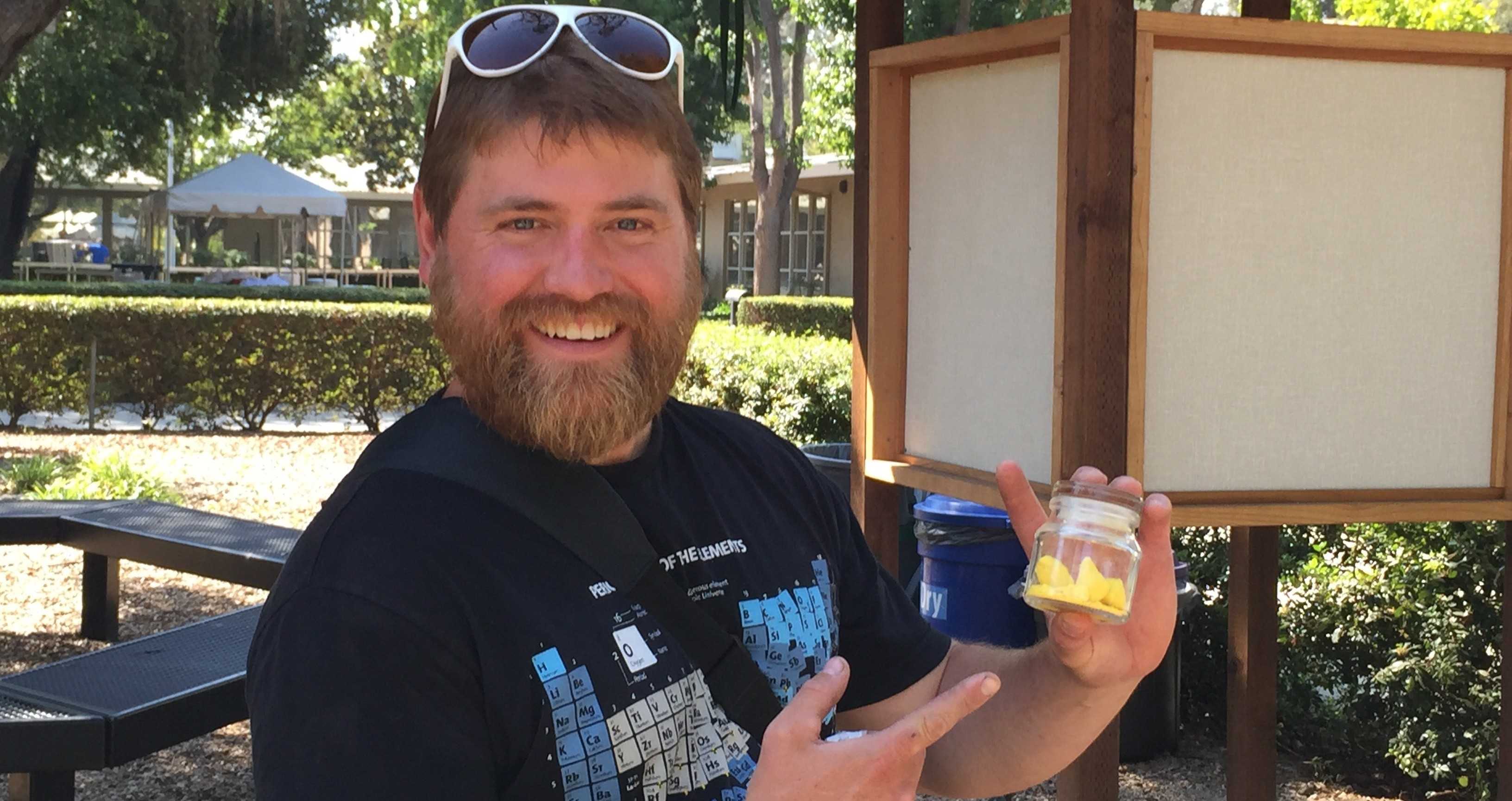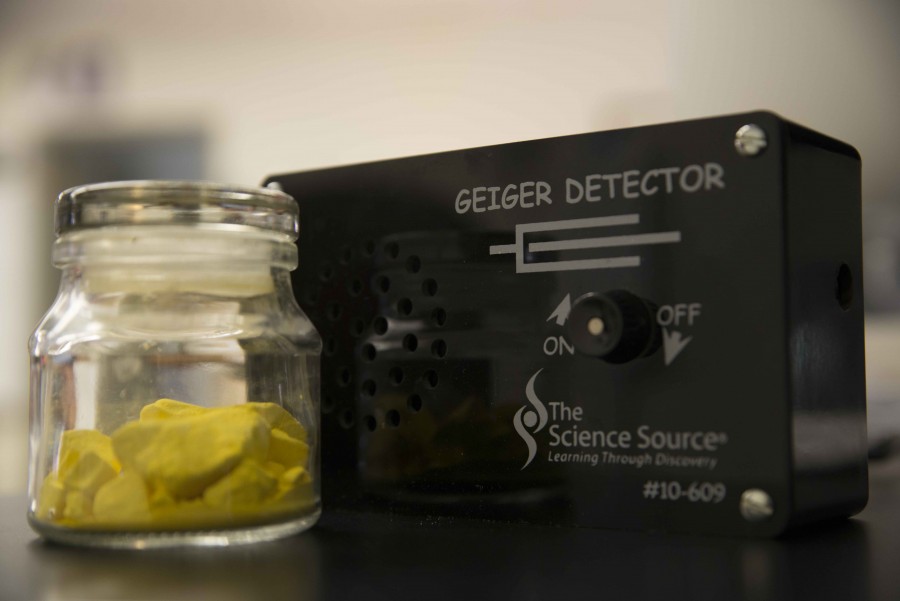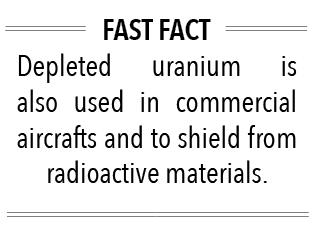Chemistry teacher infuses ceramic with depleted uranium
Andrew Irvine uses chemistry to create unique glazes
September 2, 2015
Tick. Tick. Tick. Tick. Chemistry teacher Andrew Irvine holds a clicking black box a few inches away from a pastel-yellow, glazed ceramic plate just a little larger than the size of his hand. The face of the plate is sculpted with ridges and rough crannies, and the yellow is tinted in places with tones of dusky gold and pale red.
Tickticktickticktick. As Irvine brings the box, a Geiger Counter for detecting radiation, closer to the plate, the clicking speeds up as more and more tiny alpha particles bombard the counter’s detection tube.
“It’s cool that it’s actually setting it off,” Irvine remarks with a smile.
The Geiger Counter’s ticking and the distinctive color of the ceramic both owe themselves to a remarkable quality of Irvine’s plate: its infusion with a salt of depleted uranium.
Irvine picks up the plate and turns it over in his bare hands, explaining that the plate he created is a piece of art.
According to his measurements, the depleted uranium emits radiation at 400 times the natural background level. Despite this, the radiation, mostly alpha particles, cannot pass through skin to cause damage.
“You’d think that by holding this, it would be bad. It’s not. It sounds bad when you put it here,” Irvine explains as he holds the plate close to the Geiger Counter to unleash a flurry of ticking.
He removes a glass bottle in the shape of an oversized inkwell from a box. It contains a few powdery-looking nuggets of raw uranium dioxide in a shade of yellow lighter than the plate, but just as intense in color. In the process of creating his art, Irvine sculpts the plate and prepares the glaze himself, mixing in the salt that gives the artwork its otherworldly hue.
“I’ll make a glaze body, which is usually a combination of different borosilicate materials, and in this particular solution I put in 40 percent lead carbonate, which makes it very glassy. I’ll make my glass mixture, and then I’ll add an absurd amount of uranium,” Irvine says, gesturing to the plate.
He creates his pieces in sets that take seven to eight hours to create and 13 hours to bake in a kiln.
According to the Environmental Protection Agency (EPA), a sample of natural uranium consists primarily of two isotopes, different versions of an element with the same number of protons but different numbers of neutrons. 99.3 percent of a natural sample is U-238, a weakly-radioactive substance with a long half-life, while the other seventh of a percent is U-235, a highly-radioactive substance that can sustain nuclear fission reactions. Enriching uranium artificially increases the proportion of U-235 in a sample, allowing its use in nuclear power generation or atomic bombs. Depleted uranium, by contrast, has a lower proportion of U-235, making it safe to handle.
As a consequence of its low radioactivity, uranium-238 has a half-life of 4.46 billion years, just a little shy of the age of the earth (4.5 billion years). In nearly four-and-a-half eons, half of the uranium in the plate will have decayed into Thorium-234.
“I was actually theorizing this: if the uranium changes over time, would, then, the color of my [piece] change over time?” he muses.
Irvine is not the first artist to incorporate radioactivity into his artwork. The artist and nuclear scientist James Acord worked with material from spent nuclear fuel rods in his pieces. Nor is he the first to infuse ceramic glaze with the mildly radioactive material — the glazes of Fiesta dinnerware plates were once infused with bright red uranium dioxide. The company has since abandoned the practice.
“So you wouldn’t eat off [this plate]. I would say ‘definitely not food-safe’. It’s pretty to look at,’” Irvine adds. He explains that acids and solvents in food might leach uranium from the glaze and into the human body.
Antique dinnerware and the odd art project aside, the high density of depleted uranium makes it useful for a variety of commercial applications, including as ballast in commercial aircraft and as shielding from more highly radioactive materials. Despite this, the material is not easy for private citizens to obtain.
“I was rejected several times by several vendors. I went through some different commercial vendors, and they rejected me because I didn’t meet their policy of use,” Irvine explains, adding that he received the uranium from a vendor he works with. “I called up the nuclear regulatory commission and spoke to their PR person, who sent me a long list of the regulations. As a hobbyist, I’m allowed to acquire and be in possession of up to 15 pounds of depleted uranium.”
Irvine believes that uranium is stigmatized as a material because of its association with high radiation and atomic bombs.
“Its controversy is related to its use in nuclear energy and nuclear weapons. But really as a material, when it’s depleted, its radioactivity is not the issue,” Irvine claims. “It’s [as] toxic as lead – you wouldn’t want to eat a spoonful of lead. [But] I could take my finger, rub it on that yellow stuff, and not worry about getting cancer.”
To Irvine, adding depleted uranium to ceramic is no gimmick; it’s a powerful artistic statement.
“My hope is that it will separate me even more from this idea of pottery as ceramics,” Irvine said. “Like, ‘Oh, that’s a cute mug!’ I don’t want to make mugs. I want to make fine art.”


